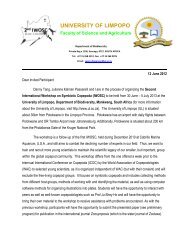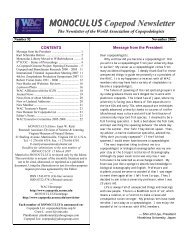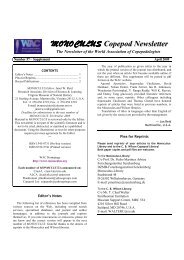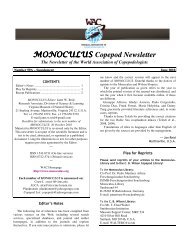Petrillo, M., M. Giallain & N. Della Croce. 2005.Zooplankton in the surrounding waters <strong>of</strong> the JuanFernández Archipelago. Revista de Biología Marina yOceanografía 40(1):63-65. [In English; abstract inSpanish.]Phelps, R.P., G.S. Sumiarsa, E.E. Lipman, H.-P. Lan, K.K.Moss & A.D. Davis. 2005. Intensive and extensiveproduction techniques to provide copepod nauplii forfeeding larval red snapper Lutjanus campechanus. Pp.151-168 In: Lee, C.-S., P.J. O’Bryen & N.H. Marcus(eds.). Copepods in Aquaculture. Blackwell Publishing,Oxford, U.K. 352 pp.Phillips, G., A. Kelly, J.-A. Pitt, R. Sanderson & E. Taylor.2005. The recovery <strong>of</strong> a very shallow eutrophic lake,20 years after the control <strong>of</strong> effluent derived phosphorus.Freshwater Biology 50(10):1628-1638.Picard, V. & N. Lair. 2005. Spatio-temporal investigationson the planktonic organisms <strong>of</strong> the Middle Loire(France), during the low water period: biodiversity andcommunity dynamics. Hydrobiologia 551(1):69-86.Pierson, J.J., C. Halsband-Lenk & A.W. Leising. 2005.Reproductive success <strong>of</strong> Calanus pacificus duringdiatom blooms in Dabob Bay, WA. Progress inOceanography 67(3-4):314-331.Pierson, J.J., A.W. Leising, C. Halsband-Lenk & N. Ferm.2005. Vertical distribution and abundance <strong>of</strong> Calanuspacificus and Pseudocalanus newmani in relation tochlorophyll a concentrations in Dabob Bay, WA.Progress in Oceanography 67(3-4):349-365.Pinder, A.M., S.A. Halse, J.M. McRae & R.J. Shiel. 2005.Occurrence <strong>of</strong> aquatic invertebrates <strong>of</strong> the wheatbeltregion <strong>of</strong> Western Australia in relation to salinity.Hydrobiologia 543:1-24.Pinto-Coelho, R.M., J.F. Bezerra-Neto & C.A. Morais Jr.2005. Effects <strong>of</strong> eutrophication on size and biomass <strong>of</strong>crustacean zooplankton in a tropical reservoir. BrazilianJournal <strong>of</strong> Biology 65(2):325-338.Pinto-Coelho, R.M., A. Giani, C.A. Morais Jr., E. CarvalhoJr. & J.F. Bezerra-Neto. 2005. The nutritional status <strong>of</strong>zooplankton in a tropical reservoir: effects <strong>of</strong> foodquality and community structure. Brazilian Journal <strong>of</strong>Biology 65(2):313-324.**Pipan, T. 2005. Epikarst – a promising habitat. Copepodfauna, its diversity and ecology: a case study fromSlovenia (Europe). Karst Research Institute at ZRCSAZU, Postojna, and ZRC Publishing, Ljubljana.Carsologica 5: 1-101.Pohnert, G. 2005. Diatom/copepod interactions in plankton:the indirect chemical defense <strong>of</strong> unicellular algae.ChemBioChem 6(6):946-959.Poulin, R. 2005. Book review: Kearn, G.C. Leeches, Liceand Lampreys: A Natural History <strong>of</strong> Skin and GillParasites <strong>of</strong> Fishes. Fish and Fisheries 6(3):277-277.Poulsen, L.K. & T. Kiørboe. 2005. Coprophagy andcoprorhexy in the copepods Acartia tonsa and Temoralongicornis: clearance rates and feeding behaviour.Marine Ecology Progress Series 299:217-227.Pracheil, B.M., G.E. Mestl & P.M. Muzzall. 2005. Metazoanparasites <strong>of</strong> young-<strong>of</strong>-the-year paddlefish from Lewisand Clark Lake, Nebraska, U.S.A. ComparativeParasitology 72(2):227-229.Præbel, K. & H. Ramløv. 2005. Antifreeze activity in thegastrointestinal fluids <strong>of</strong> Arctogadus glacialis (Peters1874) is dependent on food type. Journal <strong>of</strong>Experimental Biology 208:2609-2613.Puello-Cruz, A.C., B. González-Rodríguez, A. García-Ortega & S. Gómez. 2005. Use <strong>of</strong> the tropicalharpacticoid copepod Tisbe monozota Bowman, 1962(Copepoda: Harpacticoida: Tisbidae) as live food inmarine larviculture. Pp. 177-187 In: Hendrickx R., M.E.(ed.). Contributions to the Study <strong>of</strong> East PacificCrustaceans. Contribuciones al Estudio de los Crustáceosdel Pacífico Este. Vol. 3. Instituto de Ciencias del Mar yLimnología, Unidad Académica Mazatlán, Mazatlán.245 pp.Pulido-Villena, E., I. Reche & R. Morales-Baquero. 2005.Food web reliance on allochthonous carbon in two highmountain lakes with contrasting catchments: a stableisotope approach. Canadian Journal <strong>of</strong> Fisheries andAquatic Sciences / Journal Canadien des SciencesHalieutiques et Aquatiques 62(11):2640-2648.Queiroga, H., C. Silva, J.-C. Sorbe & F. Morgado. 2005.Composition and distribution <strong>of</strong> zooplankton across anupwelling front on the northern Portuguese coast duringsummer. Hydrobiologia 545(1):196-207.Radwanska, U. & A. Radwanski. 2005. Myzostomid andcopepod infestation <strong>of</strong> Jurassic echinoderms: A generalapproach, some new occurrences, and/or re-interpretation<strong>of</strong> previous reports. Acta Geologica Polonica 55(2):109-130.Raes, M. & A. Vanreusel. 2005. The metazoan mei<strong>of</strong>aunaassociated with a cold-water coral degradation zone inthe Porcupine Seabight (NE Atlantic). In: Freiwald, A. &J.M. Roberts (eds.) Cold-water Corals and Ecosystems.pp. 821-847.Ramfos, A., S. Somarakis, C. Koutsikopoulos & N.Fragopoulu. 2005. Summer mesozooplanktondistribution in coastal waters <strong>of</strong> central Greece (easternMediterranean). I. Hydrology and group composition.Journal <strong>of</strong> the Marine Biological <strong>Association</strong> <strong>of</strong> theUnited Kingdom 85(4):755-764.Ramfos, A., S. Somarakis, C. Koutsikopoulos & N.Fragopoulu. 2005. Summer mesozooplanktondistribution in coastal waters <strong>of</strong> central Greece (easternMediterranean). II. Species assemblages. Journal <strong>of</strong> theMarine Biological <strong>Association</strong> <strong>of</strong> the United Kingdom85(4):765-774.Randall, J., P. Lobel & C. Kennedy. 2005. Comparativeecology <strong>of</strong> the gobies Nes longus and Ctenogobiussaepepallens, both symbiotic with the snapping shrimp34
Alpheus floridanus. Environmental Biology <strong>of</strong> Fishes74(2):119-127.Rathod, V. 2005. Zooplankton studies with special referenceto krill Euphausia superba Dana from fishing area 58 <strong>of</strong>Indian Ocean sector in Southern Ocean. Current Science,Bangalore 89(4):681-686.Raul, C. & M.T. González. 2005. Clavellotis sebastidis sp.nov. (Copepoda, Lernaeopodidae) parasitic on Sebastesoculatus Valenciennes, 1833 from Argentina. ActaParasitologica 50(1):74-79.Ré, P., U. Azeiteiro & F. Morgado (eds.). 2005. Ecologia doPlâncton Marinho e Estuarino. Edições Afrontamento,Porto, Colecção Ciências e Natureza No. 1. 140 pp.ISBN-972-36-0749-2.Relyea, R.A. 2005. The impact <strong>of</strong> insecticides andherbicides on the biodiversity and productivity <strong>of</strong> aquaticcommunities. Ecological Applications 15(2):618-627.Revie, C., G. Gettinby & P. Heuch. 2005. Do Scottish andNorwegian salmon farmers face different challenges incontrolling sea lice? Fish Farmer 2005: 10-11.Revie, C.W., C. Robbins, G. Gettinby, L. Kelly & J.W.Treasurer. 2005. A mathematical model <strong>of</strong> the growth <strong>of</strong>sea lice, Lepeophtheirus salmonis, populations on farmedAtlantic salmon, Salmo salar L., in Scotland and its usein the assessment <strong>of</strong> treatment strategies. Journal <strong>of</strong> FishDiseases 28(10):603-613.Rhodes, A. & L. Boyd. 2005. Formulated feeds forharpacticoid copepods: implications for populationgrowth and fatty acid composition. Pp. 61-73 In: Lee, C.-S., P. O’Bryen & N. Marcus (eds.). Copepods inAquaculture. Blackwell Publishing, Oxford, U.K. 352pp.Riandey, V., G. Champalbert, F. Carlotti, I. Taupier-Letage& D. Thibault-Botha. 2005. Zooplankton distributionrelated to the hydrodynamic features in the AlgerianBasin (western Mediterranean Sea) in summer 1997.Deep Sea Research Part I: Oceanographic ResearchPapers 52(11):2029-2048.Richoux, N.B., D. Deibel, R.J. Thompson & C.C. Parrish.2005. Seasonal and developmental variation in the fattyacid composition <strong>of</strong> Mysis mixta (Mysidacea) andAcanthostepheia malmgreni (Amphipoda) from thehyperbenthos <strong>of</strong> a cold-ocean environment (ConceptionBay, Newfoundland). Journal <strong>of</strong> Plankton Research27(8):719-733.Riedel, R. & B.A. Costa-Pierce. 2005. Feeding ecology <strong>of</strong>Salton Sea Tilapia (Oreochromis spp.). Bulletin <strong>of</strong> theSouthern California Academy <strong>of</strong> Sciences 104(1):26-36.Ríos-Jara, E. 2005. Effects <strong>of</strong> lunar cycle and substratumpreference on zooplankton emergence in a tropical,shallow-water embayment, in southwestern Puerto Rico.Caribbean Journal <strong>of</strong> Science 41(1):108-123.Rippingale, R.J. & M.F. Payne. 2005. Suitability <strong>of</strong> thecopepod Gladi<strong>of</strong>erens imparipes for intensive cultivationfor aquaculture. Pp. 107-118 In: Lee, C.-S., P.J. O’Bryen35& N.H. Marcus (eds.). Copepods in Aquaculture.Blackwell Publishing, Oxford, U.K. 352 pp.Rivier, I.K. 2005. Composition and some ecological features<strong>of</strong> winter zooplankton in deep stratified lakes. RussianJournal <strong>of</strong> Ecology 36(3):179-192.Rodriguez-Grana, L., L. Castro, M. Loureiro, H.E. Gonzalez& D. Calliari. 2005. Feeding ecology <strong>of</strong> dominant larvalmyctophids in an upwelling area <strong>of</strong> the HumboldtCurrent. Marine Ecology Progress Series 290:119-134.Rohde, K. (ed.). 2005. Marine Parasitology. CSIROPublishing, Collingwood, Victoria. 592 pp.Romo, S., M.-J. Villena, M. Sahuquillo, J.M. Soria, M.Giménez, T. Alfonso, E. Vicente & M.R. Miracle. 2005.Response <strong>of</strong> a shallow Mediterranean lake to nutrientdiversion: does it follow similar patterns as in northernshallow lakes? Freshwater Biology 50(10):1706-1717.Rossetti, G. 2005. Fungal parasitism in freshwater calanoidpopulation: ecological consequences and possiblemechanisms involved in the infection process.Hydrobiologia 548(1):167-176.Russell, B.D., B.M. Gillanders & S.D. Connell. 2005.Proximity and size <strong>of</strong> neighbouring habitat affectsinvertebrate diversity. Marine Ecology Progress Series296:31-38.Rybak, J.I.& L.A. Bledzki. 2005. Widłonogi Copepoda:Cyclopoida. Klucz do oznaczania. [Copepoda:Cyclopoida. Key for identification.] Inspekcja OchronySrodowiska, Warsaw. 127 pp. [In Polish.] PDF alsoavailable at:http://www.gios.gov.pl/dokumenty/widlonogi_calosc.pdfSaarinen, M. & J. Taskinen. 2005. Long-lasting effect <strong>of</strong>stress on susceptibility <strong>of</strong> a freshwater clam to copepodparasitism. Parasitology 130(Pt 5):523-529.Samak, O.A.A. 2005. Mode <strong>of</strong> attachment andhistopathological impacts associated with the parasiticcopepod Lernanthropus kroyeri infesting gills <strong>of</strong> the SeaBass fish, Dicentrarchus labrax in Egypt. Journal <strong>of</strong> theEgyptian German Society <strong>of</strong> Zoology 48(D):1-22.Sampaio de Souza, C., P. Mafalda Jr., S. Sallés, T. Ramirez,D. Cortés, A. Garcia, J. Mercado & M. Vargas-Yañez.2005. Tendencias estacionales y espaciales en lacomunidad mesozooplanctónica en una serie temporalplurianual en el noroeste del Mar de Alborán, España.(Seasonal and spatial trends in the mesozooplanktoncommunity at pluriannual temporal series in the NW <strong>of</strong>the Alborán Sea, Spain.) Revista de Biología Marina yOceanografía 40(1):45-54. [In Spanish; abstract inEnglish.]Sanford, M.R., K. Chan & W.E. Walton. 2005. Effects <strong>of</strong>inorganic nitrogen enrichment on mosquitoes (Diptera:Culicidae) and the associated aquatic community inconstructed treatment wetlands. Journal <strong>of</strong> MedicalEntomology 42(5):766-776.Sarkar, R.R., S. Pal & J. Chattopadhyay. 2005. Role <strong>of</strong> twotoxin-producing plankton and their effect onphytoplankton-zooplankton system - a mathematical
- Page 1 and 2: MONOCULUS Copepod NewsletterThe New
- Page 3 and 4: United States Antarctic Research Pr
- Page 5 and 6: Commission Internationale pour la M
- Page 7 and 8: and Limnology 14(1):17-26.Lavens, P
- Page 9 and 10: Denmark, National Environmental Res
- Page 11 and 12: Wexels Riser, C., P. Wassmann, K. O
- Page 13 and 14: Escribano, R., M. Fernández & A. A
- Page 15 and 16: [Dynamics of the zooplankton commun
- Page 17 and 18: Intergovernmental Oceanographic Com
- Page 19 and 20: Barz, K. & H.-J. Hirche. 2005. Seas
- Page 21 and 22: Capitanio, F.L., M. Pájaro & G.B.
- Page 23 and 24: 2005. Dynamics of ground water cope
- Page 25 and 26: supply of fish larvae and impact of
- Page 27 and 28: Huyer, A., J.H. Fleischbein, J. Kei
- Page 29 and 30: Krśinić, F. 2005. Speleohvarella
- Page 31 and 32: Mastrantuono, L. & T. Mancinelli. 2
- Page 33: Acartia tonsa: implication for vert
- Page 37 and 38: Syndinium turbo (Dinoflagellata, Sy
- Page 39 and 40: Troedsson, C., O. Grahl-Nielsen & E
- Page 41 and 42: later developmental stages (CV-CVI)
- Page 43 and 44: Kane, Douglas D. 2004. The developm
















